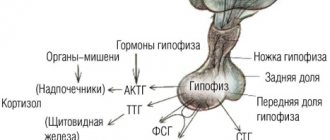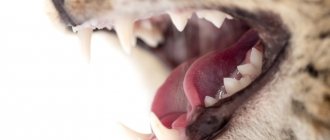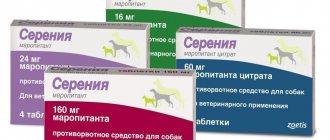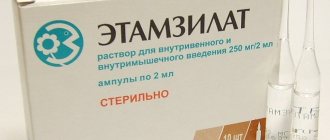Insulinoma in dogs and cats is a hormonally active tumor of the pancreas, which results in an uncontrolled increase in insulin production. Excessive amounts of the hormone lead to a decrease in blood glucose levels, which is a dangerous condition for the pet.
Insulinoma can be benign and malignant , the second occurs in approximately 85-90% of all cases . In dogs, insulin-producing carcinoma is characterized by rapid development of metastases. The pathology is also diagnosed in cats, as well as in domesticated ferrets. Pancreatic cancer most often affects older animals.
Modern veterinary medicine does not have confirmed scientific data on the genetic predisposition of animals to the disease. The disease is most often recorded in German shepherds, poodles, boxers, and collies.
From veterinary practice, it has been noted that the cause of insulinoma in dogs and cats can be prolonged fasting. Against the background of a chronic decrease in blood sugar, beta cells of the pancreas begin to actively divide, which provokes the development of a tumor. Excessive physical activity, nervous exhaustion, and prolonged stress in an animal can also provoke a malignant process.
A critical decrease in blood glucose, which occurs against the background of excessive insulin synthesis, leads to the occurrence of hypoglycemic syndrome in a sick animal. As a result of low blood glucose concentrations, tissues and organs receive insufficient energy. The body compensates for this situation by increasing gluconeogenesis, which is accompanied by an increase in the level of fatty acids and ketone bodies.
Symptoms of insulinoma:
- Lethargy, apathy. In some cases, ataxia, drowsiness, weakness and even collapse.
- As a result of a sharp drop in blood sugar levels, which is severe stress for the brain, the dog may experience inappropriate behavior and depressive symptoms.
- A sick pet may experience both a sharp decrease in body weight and obesity.
- Decreased appetite or, conversely, bulimia.
- Increased thirst, accompanied by frequent urination.
- Some individuals fall into a lethargic sleep.
- Against the background of hypoglycemia, convulsions, paresis of the posterior part of the body and other neurological manifestations develop.
Similar clinical signs are observed in cats.
Detection of low blood sugar concentrations against the background of high insulin levels is the basis for examining your pet. The complex includes:
- Biochemical blood test . Before taking the test, the owner must undergo a 12-hour fasting diet.
- X-ray and ultrasound examination to identify tumors and areas of metastasis.
- Computer tomogram. Allows visualization of small tumors.
- In some cases, the animal undergoes a diagnostic laparotomy , as a result of which a single insulinoma or multiple inoperable neoplastic nodules are discovered.
Ultrasound.
Insulinoma. Differential diagnosis is carried out in relation to oncological processes in the liver and brain, hypoadrenocorticism, renal failure, epilepsy and poisoning.
Conservative and surgical methods are used to treat cats and dogs. The most radical way to cure insulinoma in pets is to surgically remove it. In some cases, the tumor can be excised during diagnostic laparotomy.
At home, the owner of a sick dog should ensure peace and minimize physical activity. A sick dog should be fed in small portions 5-6 times a day. This regimen is gentle on the pancreas and helps maintain blood glucose at a constant level.
To relieve seizures caused by low blood glucose levels, intravenous infusions of a 40% glucose solution are used . Non-surgical therapy consists of prescribing corticosteroid drugs (Prednisolone) . If the use of glucocorticoids does not give positive dynamics, then Diazoxide and Sandostatin are used to treat insulinoma.
During drug therapy, the owner should be aware that a 40% glucose solution should not be constantly used. Long-term use of Prednisolone can lead to the development of iatrogenic hyperadrenocorticism in your pet.
A good therapeutic effect for pancreatic carcinoma is observed from the use of Streptozotocin, Adriamycin . Drug therapy can extend the life of a pet in some cases up to one and a half years.
In veterinary practice, isolated cases of insulin-producing carcinoma in cats have been reported . The symptoms of the disease are not much different from the clinical manifestations of the tumor in dogs. Treatment is medicinal in nature; in rare cases, surgical removal of the tumor is performed in cats.
Detected insulinoma in cats and dogs does not give a favorable prognosis . If the insulin-producing carcinoma is single and no metastases are found in nearby tissues, then after surgical removal and appropriate drug treatment the animal can live up to 4-5 years.
If the neoplasm in the pancreas is malignant and the process of metastasis is evident, then the life expectancy of a dog or cat will not exceed 4-6 months.
Read more in our article about insulinoma in dogs and cats.
What is insulinoma in dogs
The pancreas contains special beta cells that produce insulin.
The pathological growth of these structures leads to the development of insulinoma in dogs, which is a hormonally active tumor.
Neoplastic processes in the functional tissue of the pancreas provoke an uncontrolled increase in insulin production. Excessive amounts of the hormone lead to a decrease in blood glucose levels, which is a dangerous condition for the pet.
In veterinary practice, a distinction is made between benign and malignant forms of pancreatic tumors. Cancer accounts for approximately 85-90% of all cases of insulinoma detected in dogs. In four-legged pets, insulin-producing carcinoma is characterized by rapid development of metastases. Pathology is diagnosed in cats, as well as in domesticated ferrets. Pancreatic cancer most often affects older animals.
We recommend reading about basic hormone tests in dogs. From the article you will learn about what and when it is recommended to take tests for hormones in dogs, normal indicators, and what deviations in the tests will indicate.
And here is more information about when and how a dog has a CT scan.
Diabetes mellitus in dogs and cats. Interview with an endocrinologist
October 17, 2013
Natalya Sergeevna Smirnova, a veterinary endocrinologist at the Biocontrol clinic, talks about what kind of disease this is, what its symptoms are, how to treat it and how to care for a pet with this disease.
— What is diabetes mellitus?
— Diabetes mellitus is a condition associated with an absolute or relative deficiency of insulin, due to which the level of glucose in the blood increases. Absolute deficiency develops due to a decrease in insulin production by the pancreas. Diabetes mellitus that occurs for this reason is called insulin-dependent, or “type 1 diabetes.”
Relative deficiency, in turn, is associated with tissue resistance to the action of insulin, despite the fact that the pancreas produces it in normal or even increased quantities. This condition is typical for non-insulin-dependent diabetes mellitus or “type 2 diabetes”. Often relative and absolute deficiency exist in parallel in the body.
— That is, an animal can have two types of diabetes at the same time?
- To some extent, yes. It is difficult to distinguish them from each other and, to be honest, such a division is quite arbitrary, since there are no specific analyzes that would make it possible to distinguish between these 2 conditions. However, it has been revealed that in the vast majority of cases, the development of diabetes mellitus in dogs occurs precisely because of a lack of insulin (that is, type 1 diabetes occurs). Moreover, in 80-85% of cats, on the contrary, the initial development of diabetes is associated with tissue resistance to its action due to obesity and a sedentary lifestyle (that is, type 2 diabetes mellitus occurs).
— Owners often use the terms “mellitus” and “non-diabetes,” what is it?
“These are two completely different diseases that have no connection with each other. Diabetes mellitus, as I already said, is a condition in which the level of glucose in the blood is elevated. In diabetes insipidus, glucose levels remain normal. These two diseases share only some common clinical symptoms, such as sharply increased thirst and frequent urination in large quantities.
Diabetes insipidus is caused by the fact that the kidneys, for one reason or another, cannot concentrate urine. As a result, urine is produced that is highly diluted, like water.
— What are the symptoms of diabetes?
— First of all, the owner pays attention to the increase in thirst in the pet, as well as frequent excessive urination. Often dogs, for example, can’t wait to go for a walk and pee at home.
As the disease progresses, the animal's appetite increases, while body weight decreases. In the later stages, the animal begins to refuse food, severe dehydration, vomiting, and general weakness appear.
— In which animals is diabetes mellitus more common? Who is susceptible to it?
— Diabetes mellitus can develop in any animal. It mainly affects middle-aged and older dogs and cats.
— We often hear from owners: “My pet will only have diabetes if I feed him cookies and candy.” Is this true or a myth? How are sweets and diabetes related?
— There is such an opinion among owners, but it is not entirely true. Even if you feed your animal candy every day, this does not guarantee that sooner or later he will develop diabetes, just as proper feeding does not guarantee that the animal will not develop diabetes. Of course, if we give an animal sweet food, the glucose level will increase and this will lead to additional stress on the pancreas. However, there is no direct relationship between sweets and diabetes. Regular feeding of cookies, candies and other sweets is more likely to lead to obesity and, as a result, to diabetes. In addition, such a diet increases the risk of developing pancreatitis.
— If an animal is admitted to a therapist and the doctor suspects he has diabetes, what tests or studies will need to be performed?
— First of all, if you suspect diabetes mellitus, you need to take biochemical and clinical blood tests. Biochemical analysis is necessary not only to determine glucose levels, but also to identify concomitant pathologies, for example, from the liver or kidneys, which are often found in diabetes mellitus. A clinical blood test will reveal the presence of a systemic inflammatory process.
It is also necessary to take a urine test, perform an abdominal ultrasound and, if we are dealing with a cat, take a fructosamine test.
— What is fructosamine and why take this test?
— Fructosamine is a protein that transports glucose. The fact is that in cats under stress (and a trip to the clinic is always very stressful), the glucose level can increase quite noticeably, up to 15 mmol or even higher. In this situation, it can be quite difficult to tell whether the patient has diabetes or whether it is the result of stress. Fructosamine allows us to distinguish a true increase in glucose from a stress one. It circulates in the blood for two to three weeks and its amount increases gradually, following the gradual increase in blood glucose levels in the case of diabetes. Therefore, if the animal is truly diabetic, fructosamine will be increased. Under stress, this indicator remains within the normal range. But this only applies to cats. In dogs, an increase in fasting glucose above 14 mmol always indicates the presence of diabetes.
— What does the treatment of such patients include?
— Treatment tactics are determined primarily by the patient’s condition. Diabetes mellitus can be not only type 1 or 2, but it can also occur in a complicated or uncomplicated form, and develop as a consequence of other serious diseases, for example, acute pancreatitis. What does it mean? If the animal is compensated (eating, no vomiting, no diarrhea, no serious dehydration), then we can take control of diabetes mellitus by prescribing insulin injections and diet.
If we are talking about an animal that arrived in a serious condition, for example, after several days of anorexia, with repeated vomiting or diarrhea, in a state of severe dehydration (dehydration) and in a recumbent position, then the treatment of such a patient will, of course, be much more complex, with mandatory placement in a hospital for daily infusion therapy, regular glucose monitoring and, of course, selection of the correct dose of insulin.
— Is this disease curable?
— In some situations, curing diabetes mellitus is indeed possible. For example, dogs can develop diabetes in the first months after estrus. This is due to the production of a certain hormone that interferes with the action of insulin. In this case, in a number of animals, sterilization along with insulin therapy can solve the problem, that is, within one to two months after sterilization, insulin can be discontinued.
If we talk about cats, then the chances of curing diabetes directly depend on the time of seeing a doctor. The earlier the problem is identified, the higher the chance of cure. Reducing the insulin dose and then stopping it usually occurs within three to six months. If the need for insulin does not decrease after six months of therapy, then the chances of curing diabetes become extremely small.
- Insulin. Who calculates the dosage and how and why should it not be exceeded?
— The choice of insulin is determined only by the doctor. Insulin can be short-acting, intermediate-acting or long-acting, human or veterinary. Depending on the condition in which the patient arrives, as well as on whether it is a dog or a cat, insulin is selected. Insulin that works well in dogs will not always work well in cats, and vice versa.
The dose of the drug is also determined by the doctor. At the initial appointment, the initial dose of the drug is selected, which is then, within one to four weeks, adapted to the specific patient, of course, under the supervision of a doctor. Self-treatment of diabetes is impossible, since if the dose is exceeded, the glucose level can drop to very low values (below 2 mmol), which can lead to serious problems for the health of the animal and even lead to death.
— Should insulin be injected only with a special insulin syringe?
— Yes, but there are special syringes for different types of insulin. They come in different gradations and volumes (100 U/ml, 40 U/ml, 50 U/0.5 ml, etc.) When the owner comes to the pharmacy, he must very clearly understand which syringe he needs (on the issue of insulin overdose ), since pharmacists themselves do not always concentrate their attention on this. Usually, during an appointment, the doctor explains in great detail which syringe is needed for each specific patient.
— What does home treatment include?
— Home treatment primarily includes regular daily insulin injections at the same time (usually 2 times a day) with mandatory periodic glucose measurements. In addition, a special diet is prescribed. If there are concomitant pathologies, they are treated.
— Do animals need any special diet for diabetes?
— Today, there are specialized commercial foods for diabetes for cats and dogs in dry and canned forms. The goal of such a diet is to maintain the most even glucose levels throughout the day, without spikes. Feeding a therapeutic diet is also aimed at reducing the animal’s weight. This is necessary, since most cats and dogs with diabetes are obese, which, let me remind you, is the main risk factor in the development of this disease.
Treatment of diabetes is also possible if the animal refuses industrial feed. However, even a natural diet should be selected together with a doctor, depending on the type of animal and its preferences.
The key to success in treating diabetes is the monotonous rhythm of your animal’s life every day: injections, nutrition, exercise.
— Does diabetes mellitus affect the life expectancy of an animal?
- In fact, with compensated diabetes mellitus, an animal can live quite a long time, until its physiological old age, and die from a completely different pathology. Such animals are visually no different from others. But, when an animal is admitted in serious condition due to uncompensated diabetes, the doctor’s forecasts are much more cautious, since not all animals, unfortunately, can be stabilized.
— How to prevent diabetes mellitus?
— The most important thing is to control the pet’s weight. A very small percentage of animals in which we detect diabetes have normal body weight. First of all, this applies to cats and kittens. For dogs, sterilization comes first among recommendations.
— How often should patients with diabetes see a doctor?
— If the patient’s condition is stable, then monitoring glucose levels and adjusting the dose of the drug are carried out over the phone. Regular visits to the doctor are not required. The need to visit the clinic depends on many factors: test results at the time of diagnosis, the presence of concomitant pathologies, and others. As a rule, the patient comes for a re-examination after two to four weeks, and then every three to six months.
LYUDMILA (07/22/2016 at 19:46): thank you for the useful information. My cat is sick, his blood sugar is high, but in Vladivostok we practically do not treat this disease in cats. I only wasted my precious time and money on tests, on a glucometer, etc., and received no help from false specialists. One good doctor. who is now taking care of my cat, told the truth about animal diabetes. But I asked this doctor not to refuse me treatment and to help alleviate the plight of my cat. and My cat lived for a year without problems and without insulin. until he started stealing from the table, his condition worsened again. His hind legs began to weaken and his sugar levels increased. Now my cat needs help, how to restore muscle weakness in his hind legs? Help. Please!
Reply | to write a message
- Biocontrol (07/25/2016 at 10:11): Lyudmila, hello. It is better to ask our therapists directly about your question. This can be done on the forum, here:
Reply | to write a message
Zoya (08/04/2016 at 01:56): My cat (5 years old) has symmetrical baldness on her tummy after sterilization 4 years ago and recently appeared on her hips. In addition, she began to chew out the hair on her hind legs. I visited the doctor. They said allergies. We took tests - sugar level was 13. Otherwise everything was fine. The doctor said it could be due to stress. She really reacts very poorly to being carried both on foot and by car (vomiting, urine, stool, salivation). I replaced the food with Bosch Sanabel Sensitive with lamb. Continues to itch. I canceled all treats. Stopped giving Agusha. But in general she only eats dry food, and I thought that was why she drinks a lot. Weight is within normal limits. Please advise what to do next. Going somewhere else to see a doctor is simply torture for her. Even when I walked 10 minutes to the veterinary clinic, she was covered in saliva and even squeaked.
Reply | to write a message
Zoya (08/04/2016 at 01:58): I wrote, I wanted to write.
Reply | to write a message
Zoya (08/04/2016 at 02:03): Maybe you can recommend some other food for allergies. She always ate only premium food (Bozitu, Leonardo, Akana). Thank you in advance.
Reply | to write a message
- Biocontrol (08/04/2016 at 09:05): Zoya, hello. It is better to ask questions to therapists directly. This can be done on our forum, here:
Reply | to write a message
Zoya (08/05/2016 at 02:41): Thank you very much. I'll definitely contact you.
Reply | to write a message
Vera Kholod (12/08/2016 at 11:44 pm): My dachshund is 17 years old, on insulin for the second year. It's getting worse and worse. And today he stopped eating completely, he just drinks and pees. I don't inject insulin. But what if he doesn’t eat tomorrow?
Reply | to write a message
- Biocontrol (12/09/2016 at 09:00): Vera, hello. Based on your description, it is difficult to recommend anything; your Dachshund needs to be examined. Don't put off visiting your doctor.
Reply | to write a message
Svetlana (01/07/2017 at 12:41): Good afternoon. I have a question for the endocrinologist: the cat has elevated blood glucose levels. Today at 7 am 26.4 at 11-00 28. The doctor prescribed insulin, we give injections 2 times a day with measuring glucose levels and in addition to injections the doctor prescribed Glibenclamide 5 mg, one third of a tablet, 2 times a day. Please tell me, is this combination of medications dangerous?
Reply | to write a message
Guzel (03.03.2017 at 00:48): hello, after discovering diabetes in a cat. The vet prescribed us caninsulin. but at night for some reason the cat vomits bile?
Reply | to write a message
- Biocontrol (03/03/2017 at 09:19): Guzel, hello! It is better to ask this question directly to our doctors. Do it on the forum, here:
Reply | to write a message
Lyudmila (03/10/2017 at 00:48): Hello. My husky is 12 years old. A year ago, after being in heat, she developed diabetes. We sterilized him and selected a dose of caninsulin plus specialized food. Before this, there was also Royal Canin, but regular, non-diabetic, plus raw meat was added to the food two or three times a week, because the dog always advertised the need for red meat. Question: How much does adding raw/cooked meat to a dog’s diet affect the current situation with diabetes? (Only on diabetic dry food, without adding meat, the dog remains hungry.
Reply | to write a message
- Oksana (09.17.2017 at 15:55): Hello, can you tell me how a dog at 12 years old underwent surgery? Our dog is 12-13 and is also on insulin now. The doctor says that sterilization can help solve the sugar problem. But it's 50/50. And we need to make a decision. Aged dog
Reply | to write a message
Lyudmila (03/10/2017 at 01:01): And the second question: what to do if between two injections and two feedings a day, as prescribed by the veterinarian (at 8 am and at 20 pm), the dog advertises severe hunger already around 6 pm. And it costs a lot to calm and hold the dog until 20 pm. Our physical activity is normal, higher than that of sofa dogs. Thank you in advance for your answers.
Reply | to write a message
- Biocontrol (03/10/2017 at 09:09): Lyudmila, good afternoon! Regarding your question, it is better for you to communicate with Natalya Sergeevna directly. You can do this on our forum, in the “Questions to the therapist” section, here:
Reply | to write a message
Irina Odintsova (03/12/2017 at 05:19 pm): They prescribed cannisuline 0.05 once a day, but in the evening the dog’s sugar levels are high, and the veterinarian says this is a one-time dose and should not be given in the evening. It happens 25.6. Dog weight 4 kg, Spitz. Please advise what to do in such cases.
Reply | to write a message
- Biocontrol (03/13/2017 at 09:11): Irina, hello. It will be more convenient for you to consult with our doctors on our “Questions for a Therapist” forum. Please follow this link:
Reply | to write a message
Yulia (03/25/2017 at 07:11 pm): Good afternoon. My 25-year-old dachshund was diagnosed with diabetes mellitus, sugar level is 24 units, they prescribed Lantus 2 units, the problem is that it is completely impossible to measure sugar, blood does not come from the ear, and in the clinic it does not either. it worked out, I don’t know what to do
Reply | to write a message
Yulia (03/25/2017 at 19:11): Good afternoon. My 15-year-old dachshund was diagnosed with diabetes mellitus, sugar level is 24 units, they prescribed Lantus 2 units, the problem is that it is completely impossible to measure sugar, blood does not come out of the ear, in the clinic too It didn’t work out, I don’t know what to do
Reply | to write a message
Natalya (04.03.2019 at 23:22): My dachshund is 9 years old, the problem with high sugar began after the heat (at the end of December). Sugar rose over 30 m/mol. We also had a problem taking blood from the ear, but we had to learn , there is no need to be afraid, everything will work out. On March 1, she was sterilized, again on the day of the operation, her sugar was 24, they gave an injection of insulin, lowered it to normal and immediately went to surgery. We were warned about the consequences, there was no other way out. It’s too early to say, it passed 3 days after surgery, but sugar is no longer so high.
Reply | to write a message
Sergey (02.22.2020 at 21:49): The cat stopped eating and drinking, and so on for 3 days, they took him to the clinic, sugar level was 27, then 29.5, then lowered. Now it’s about 8-10, but doctors give a 50/50 chance of problems with the liver and kidneys. The cat is in the hospital, money is pouring into the clinic. The cat looked more cheerful, he began to drink himself, they say, but he eats forcibly. They don't say anything specifically. I'm very sorry for the cat, age 11 years
Reply | to write a message
- Biocontrol (02/25/2020 at 09:28): Sergey, hello! If you want to consult with our endocrinologist, you can do this on the Bioforum, in the “Questions to an endocrinologist” section, here:
Reply | to write a message
Tamara (07/15/2020 at 12:04 pm): Is it possible to separate the disease of cats and dogs from the disease of people. I can barely restrain myself from writing this without swearing. Whether a child or a cat is sick, there is a difference
Reply | to write a message
- Biocontrol (07/15/2020 at 14:55): Sorry, Tamara, your message is not entirely clear. The article talks about diabetes mellitus in cats and dogs, there is no talk about people. What is your complaint?
Reply | to write a message
Elena (10/11/2020 at 5:12 pm): We have an appointment with your endocrinologist for Tuesday. The cat's glucose level is 31. Tell me what can be done 2 days before the appointment.
Reply | to write a message
- Biocontrol (12.10.2020 at 14:12): Hello, Elena! Consult an endocrinologist directly here:
Reply | to write a message
Click to cancel reply.
Reasons for the development of pathology
Modern veterinary medicine does not have confirmed scientific data on the genetic predisposition of animals to the disease. As for breed predisposition, according to the observations of experienced dog breeders, the disease is most often registered in German shepherds, poodles, boxers, and collies.
Based on many years of practice, veterinary experts believe that insulinoma in dogs may be caused by prolonged fasting. Against the background of a chronic decrease in blood sugar, beta cells of the pancreas begin to actively divide, which provokes the development of a tumor. Excessive physical activity, nervous exhaustion, and prolonged stress in an animal, according to experienced dog breeders, can also provoke a malignant process.
Symptoms
Excess insulin causes hypoglycemia. The central nervous system reacts most acutely to glucose deficiency. In addition to convulsions and lethargy, the development of a tumor is manifested by the following pathological symptoms:
- intermittent claudication;
- movement coordination disorder;
- a sharp drop in blood pressure;
- loss of consciousness;
- muscle twitching;
- gluttony;
- thirst;
- obesity.
At the initial stage, attacks alternate with the disappearance of pathological symptoms. It takes 6 to 12 months from the appearance of the first signs to the development of a permanent painful condition. Seizures are not typical for ferrets: the main symptoms are weakness, drowsiness, and excessive drooling.
Symptoms of insulinoma in dogs
A critical decrease in blood glucose, which occurs against the background of excessive insulin synthesis, leads to the occurrence of hypoglycemic syndrome in a sick animal. As a result of low blood glucose concentrations, tissues and organs receive insufficient energy. The body compensates for this situation by increasing gluconeogenesis, which is accompanied by an increase in the level of fatty acids and ketone bodies.
Insulinoma in dogs leads to the development of the following symptomatic complex:
- Lethargy, apathy. In some cases, the owner experiences ataxia, drowsiness, weakness and even collapse.
- As a result of a sharp drop in blood sugar levels, which is severe stress for the brain, the dog may experience inappropriate behavior and depressive symptoms.
- A sick pet may experience both a sharp decrease in body weight and obesity.
- Decreased appetite or, conversely, bulimia.
- Increased thirst, accompanied by frequent urination.
- Some individuals fall into a lethargic sleep.
- Against the background of hypoglycemia, the dog develops seizures, paresis of the posterior part of the body and other neurological manifestations.
Similar clinical signs are observed in other pets (cats, ferrets).
Diagnostics
The first step in diagnosing insulinoma is recognizing the clinical signs associated with hypoglycemia. A plasma glucose concentration of 40 mg/dL or less confirms that these signs are caused by hypoglycemia. If glucose administration improves clinical signs, Whipple's triad is present (i.e., clinical signs of hypoglycemia, low plasma glucose, and resolution of signs with glucose administration). Whipple's triad, characterized by low blood glucose with fasting episodes of hyperinsulinism, can be observed in animals with hypoglycemia from any cause and does not indicate the presence of insulinoma. Other causes of hypoglycemia in adult animals include extrapancreatic tumor, severe liver dysfunction, toxemia of pregnancy, sepsis, insulin overdose, hypocortisolism, fasting, malabsorption, beta cell hyperplasia, and hypoglycemia in hunting dogs. Many of these differential diagnoses can be quickly ruled out during an initial history and physical examination. Once the above conditions have been ruled out, the possibility of insulinoma should be seriously considered in an adult patient with clinical signs of hypoglycemia.
Hyperinsulinism is best diagnosed by simultaneously interpreting serum insulin and glucose concentrations. If the doctor initially evaluates an animal with signs of hypoglycemia and suspects the presence of hyperinsulinism, a serum sample can be taken for analysis at this time. If attempting to document hyperinsulinism at a later date, samples should be taken after fasting when the blood glucose concentration is less than 60 mg/dL. Patients with suspected hyperinsulinism should be fasted under medical supervision so that the physician can intervene if signs of hypoglycemia occur. Samples to determine the amount of glucose in the blood must be kept in sodium fluoride. It is also important to conduct radioimmunoassay of these samples. Relative ranges vary among laboratories and animal species.
A high concentration of insulin in any animal with adverse hypoglycemia corresponds to hyperinsulinism. If a patient with hypoglycemia had insulin concentrations within the relative range, the test should be repeated again in a fasted state when the animal has two consecutive blood glucose readings of 60 mg/dL or less.
Basic medical examination (full blood count, serum chemistry panel, and urinalysis) usually does not reveal the presence of abnormalities, and chest x-rays are also not helpful in making a correct diagnosis (thoracic metastases have not been noted in animals with insulinoma). Abdominal ultrasonography is occasionally helpful in identifying pancreatic masses in dogs, cats, and ferrets with insulinoma. This procedure helps patients with low serum insulin concentrations during hypoglycemia. Abdominal ultrasound can also detect abdominal metastases and exclude tumors as the cause of hypoglycemia. Although hyperinsulinism can be confirmed by clinical pathological tests, histological examination is necessary to make an accurate diagnosis of insulinoma. All patients with hyperinsulinism are advised to undergo exploratory laparotomy if the owner wishes to continue treatment for insulinoma.
How to diagnose education
A veterinarian may suspect the development of insulin-producing carcinoma based on the history and laboratory tests indicating hypoglycemia in the pet’s body. The discovery of low blood sugar in the presence of high insulin levels warrants further evaluation of the furry patient. Owners often wonder how to diagnose insulinoma in dogs.
First of all, a professional will prescribe a biochemical blood test for the animal. Before taking the test, the owner must undergo a 12-hour fasting diet. Only in this case will the veterinarian receive reliable results.
CT scan
X-ray and ultrasound examinations often reveal large tumors in the pancreas. Using these methods, foci of metastasis are also identified. A veterinarian can visualize small tumors using a CT scan.
In some cases, the animal undergoes a diagnostic laparotomy, as a result of which a single insulinoma or multiple inoperable neoplastic nodules are discovered.
Differential diagnosis is carried out in relation to oncological processes in the liver and brain, hypoadrenocorticism, renal failure, epilepsy and poisoning.
Side effects
Allergic reactions are possible in hypersensitive animals. Hypoglycemia (in case of overdose, late feeding or skipping feeding, excessive physical activity due to diseases or infections, especially with vomiting and diarrhea), is accompanied by increased sweating, palpitations, hunger, muscle tremors, anxiety, and agitation. Diabetic acidosis and hyperglycemia (by missing an injection, low doses of caninsulin, non-compliance with the diet, against the background of infection), is accompanied by loss of appetite, thirst and drowsiness. With prolonged use of the drug, lipodystrophy develops (hypertrophy or atrophy of subcutaneous fat tissue).
Treatment of insulinoma in dogs
Once the diagnosis is confirmed, the veterinarian will prescribe treatment for insulinoma in dogs. In therapeutic practice, conservative and surgical methods are used. The most radical way to cure insulinoma in pets is to surgically remove it. In some cases, the tumor can be excised during diagnostic laparotomy.
Home care
At home, the owner of a sick dog must, first of all, ensure peace and minimize physical activity. Equally important is given to therapeutic nutrition. A sick dog should be fed in small portions 5-6 times a day. This regimen is gentle on the pancreas and helps maintain blood glucose at a constant level.
Drugs
To relieve seizures caused by low blood glucose levels, intravenous infusions of a 40% glucose solution are used. Non-surgical therapy consists of prescribing corticosteroid drugs (prednisolone) to the sick dog. If the use of glucocorticoids does not give positive dynamics, then Diazoxide and Sandostatin are used to treat insulinoma in dogs.
During drug therapy, the owner should be aware that a 40% glucose solution should not be constantly used. Long-term use of Prednisolone can lead to the development of iatrogenic hyperadrenocorticism in your pet.
A good therapeutic effect for pancreatic carcinoma is observed from the use of Streptozotocin and Adriamycin. Drug therapy can extend the life of a pet in some cases up to one and a half years.
Treatment
Acute hypoglycemia requires intravenous administration of glucose or dextrose solutions. B vitamins are prescribed.
The diet recommends the consumption of complex carbohydrates at regular intervals in feeding the animal.
Glucocorticoids are useful. Of these, prednisolone is initially 0.25 mg/kg of animal weight every 12 hours. Begin treatment with small doses. The dose can be increased to 2 mg per kg.
Diazoxide 5 mg/kg at 12-hour intervals, increasing the dose to 30 mg/kg.
A sosatostatin analogue, octreotide 15-20 mg/kg every 12 hours, shows a good effect. The drug is used in parallel with glucocorticoids.
The main treatment is surgical. To provide assistance, a partial pancreaectomy is performed.
Surgery is performed under general anesthesia with the animal in the dorsal position. Laparotomy is performed in the supra-umbilical region along the white line.
The gland affected by the tumor is separated at some distance and the intralobular artery is exposed using tweezers, the vessels are ligated and the affected part is removed.
If the affected part is not large and there are no metastases, the prognosis is favorable.
With many metastases, the patient is considered inoperable and is prescribed conservative supportive, pain-relieving therapy, if necessary.
The life expectancy of patients is from 2 months to 2 years.
Prognosis for the animal
Having learned that a dog has insulinoma, the owner wants to know what the prognosis is for this pathology. Unfortunately, veterinary specialists cannot reassure the household. If the insulin-producing carcinoma is single and no metastases are found in nearby tissues, then after surgical removal and appropriate drug treatment the dog can live up to 4-5 years.
If the neoplasm in the pancreas is malignant and the process of metastasis is evident, then the prognosis is unfavorable. The life expectancy of a dog in such a situation will not exceed 4-6 months.
We recommend reading about the signs of a malignant tumor in a dog. From the article you will learn about the causes of the formation of a malignant tumor in dogs, symptoms of organ damage, diagnosis and treatment of the disease.
And here is more information about the causes and treatment of diabetes insipidus in dogs.
Insulinoma in animals is a hormonally active neoplasm, often of a malignant nature. Older dogs are mostly susceptible to the disease. Treatment is conservative and surgical. The presence of metastases worsens the prognosis for a sick animal.











